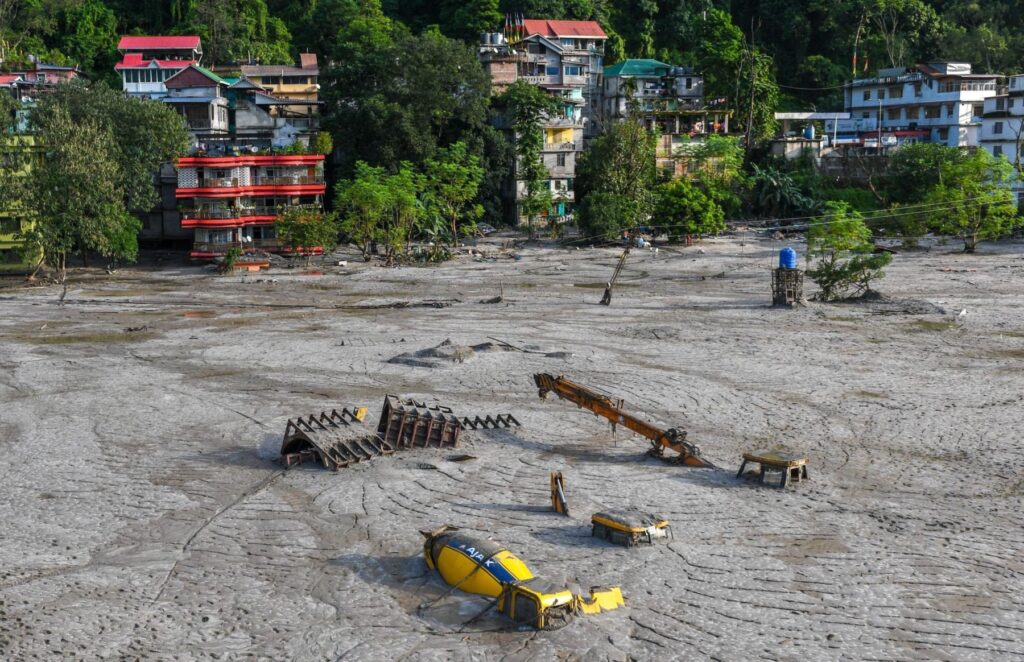Winter Snow Deficit Poses Growing GLOF Risk In The Himalayas
Mar 19, 2024 | Pratirodh Bureau
Construction vehicles were covered in debris during flash floods caused by the South Lhonak glacial lake outburst flood in northeast India, on 4 October 2023 (Image: Sipa US / Alamy Live News)
Glaciologists warn that the reduced snowfall in the Himalayas increases glacial lakes, which pose a growing risk of lake outburst floods in the region. They call for international cooperation, increasing preparedness and climate adaptation.
Since 1 January, the Himalayan state of Himachal Pradesh has seen a large deficit — of 31 per cent — in winter precipitation. Nine out of its 12 districts have received deficient precipitation, according to the Meteorological Centre in Shimla.
According to meteorologists, as warmer winters continued for the second consecutive year across India, the cumulative countrywide rainfall from 1 January to 29 February has shown a large deficit — of 33 per cent. Against the normal average of 39.8 mm, the actual rainfall recorded during the winter season was 26.8 mm.
Experts say increasing global warming has been altering weather patterns, leading to anomalies in temperature and rainfall patterns.
The Western (WDs) Disturbances — the prime weather system in the region — continued to dodge the western Himalayas as they mostly travelled in the upper latitudes.
Western Disturbances are known to bring winter weather events to north-west India and adjoining areas of central India and to drive weather activities. Both the frequency as well as the intensity of these Western Disturbances has been on the lower side this winter season.
Primarily disturbances originating in the west and travelling in the upper atmosphere in the subtropical westerly jet, WDs arrive in the Indian sub-continent during the winter. Their frequency peaks from December to February, averaging four to five events per month.
However, climate change and the glacier recession associated with it have led to the formation of new glacial lakes and the expansion of existing ones across the Himalayas recently. Several pose a potential glacial lake outburst flood threat — a climate change-induced threat to downstream communities and infrastructure.
The term ‘glacial lake outburst flood’ or GLOF, refers to the catastrophic release of a water reservoir that forms at the site of a glacier. Glaciologists warn of events similar to the GLOF event in Sikkim, in other Himalayan states as well.
A recent report on the Himalayas by the University of Zurich states that glacial lakes are highly dynamic water reservoirs that respond to climate change by expanding in volume, size and number. This is particularly evident across the mountains of Asia, including the Hindu Kush Karakoram Himalayas, the Tien Shan mountains and Tibet.
Due to climate change and consequent accelerated glacier recession, the number of glacial lakes in the Hindu Kush Karakoram Himalayas increased from 4,549 lakes (398.9 sq km) in 1990 to 4,950 lakes (455.3 sq km) in 2015.
Several large-scale and regional assessment studies have confirmed the growth of glacial lakes and their hazardous potential across Asia.
Jammu and Kashmir has the maximum combined exposure to potential GLOF events, with 556 lakes, including some designated ‘very high danger’ and ‘high danger’ lakes. Arunchal Pradesh follows it with 388 lakes and Sikkim with 219 lakes.
If we go sectorwise, Jammu and Kashmir faces the greatest GLOF threat to roads and populations, whereas the threats to croplands and hydroelectric power is greater in Arunachal Pradesh and Sikkim, respectively.
But the highest-priority lakes, where urgent monitoring and local site investigations are recommended, include 13 lakes in Sikkim, five in Himachal Pradesh, four in Jammu and Kashmir, two in Uttarakhand and one in Aruncahal Pradesh.
With the melting of glaciers, the risks of catastrophic events — landslides, sudden ice shears and in some cases, GLOFs — will rise.
According to experts, the warming observed in recent decades has been accompanied by increased frequency of avalanches in the western Indian Himalayas.
Powder snow avalanches are found to occur following intense snow precipitation during cold winter conditions. Wet and dense flows often coincide with warm spells, typically towards the end of winter and early spring.
As a result, changing climatic conditions many lead to modification of avalanche activity. According to the weather models, if warmer temperatures persist during these months, then avalanche probabilities are highest. Changes to land cover, such as deforestation and afforestation are also likely to play a role.
Therefore, extensive adaptation needs to start immediately to prepare for this future, even as mitigation to preserve glaciers as much as feasible is also prioritised.
